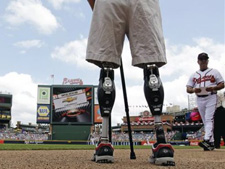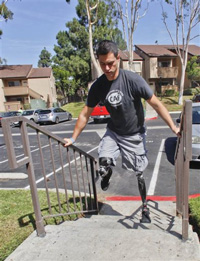redo Jump to...
print Print...

May 28, 2012: U.S. Army Capt. Dan Berschinski, uses prosthetic legs to stand on the field before a baseball game. Berschinski lost both legs to an IED blast while serving in Afghanistan in 2009.
(by Marilynn Marchione, YahooNews) AP – The bombs that made Boston look like a combat zone have also brought battlefield medicine to their civilian victims. A decade of wars in Iraq and Afghanistan has [led] to dramatic advances that are now being used to treat the 13 amputees and nearly a dozen other patients still fighting to keep damaged limbs after Monday’s attack.
“[In my opinion], the only field or occupation that benefits from war is medicine,” said Dr. David Cifu, rehabilitation medicine chief at the Veterans Health Administration.
Nearly 2,000 U.S. troops have lost a leg, arm, foot or hand in Iraq or Afghanistan, and their sacrifices have led to advances in the immediate and long-term care of survivors, as well as in the quality of prosthetics that are now so good that surgeons often choose them over trying to save a badly mangled leg.
Tourniquets [were used] in Iraq as medical personnel learned to use them properly and studies proved that they saved lives. In Boston, as on the battlefield, they did just that by preventing people from bleeding to death.
Military doctors passed on to their civilian counterparts a surgical strategy of a minimal initial operation to stabilize the patient, followed by more definitive ones days later, an approach that offered the best chance to preserve tissue from large and complex leg wounds.
At the same time, wartime demand for prosthetics has led to new innovations such as sophisticated computerized knees that work better than a badly damaged leg ever would again.

Oct. 4, 2012: U.S. Marine Cpl. Daniel Riley, 21, navigates the steps outside his apartment on his prosthetic legs. Riley lost both legs to an IED in Afhganistan. Learning to walk on his prosthetic legs was “like kicking a soccer ball in a swimming pool.”
“This is a clear case where all of the expertise that was gained by prosthetic manufacturers was gained from the wars. It’s astonishing how well they function and the things people can do with these prostheses,” said Dr. Michael Yaffe, a trauma surgeon at Beth Israel Deaconess Medical Center in Boston.
The hospital has performed amputations on three blast victims so far. A few other patients there may yet need them. Yaffe is a lieutenant colonel in the Army Reserves, and many other doctors treating Boston blast victims also have had military training.
The military partnered with the American Academy of Orthopaedic Surgeons to train doctors throughout the United States on advances learned from the wars, said Dr. Kevin Kirk, an Army lieutenant colonel who is chief orthopedic surgeon at San Antonio Military Medical Center.
Help, too, has come from Israel, which for decades has dealt with the aftermath of Palestinian bombs, like the ones in Boston, often laden with nails, ball bearings and other metals.
“Unfortunately, we have great expertise,” said Dr. Pinchas Halpern, director of emergency medicine at Tel Aviv’s Sourasky Medical Center.
Halpern, who gave lectures in 2005 at Brigham and Women’s Hospital and Massachusetts General about responding to attacks, has been in email contact with doctors in Boston this week.
Among the topics he covered in his lectures were how to coordinate ambulances to distribute the wounded to area hospitals according to their type of injury, performing more CT scans than usual to locate deep shrapnel wounds and ways to identify and classify wounds.
Dr. Paul Biddinger of Mass General’s emergency department said the hospital took much of Halpern’s advice. “We improved our plans for triage, site security, reassessment and inter-specialty coordination” following Halpern’s visit, Biddinger said.
Blast victims can be challenging to treat because they typically have multiple complex physical injuries that may include loss of limbs, fractures, brain damage, and vision and hearing impairment, said Dr. Paul Pasquina, chairman of physical medicine and rehabilitation at the Uniformed Services University and Walter Reed National Military Medical Center. …
John Fergason, chief prosthetist at Center for the Intrepid, an outpatient rehab center that is part of Brooke Army Medical Center, said advances include computerized knees that allow amputees with above-the-knee amputations to walk down steep ramps, to walk up steps and go from a walk to a run.
After every war, “you see a tremendous spike in prosthetic innovation,” largely because of increased research money, said Hugh Herr, a prosthetic expert at MIT and a double-amputee himself. Federal funds let his MIT lab do basic research on a bionic foot-ankle-calf system, and he founded a company that has commercialized that device.
If Boston victims are generally healthy and motivated, and their legs are amputated below the knees, or perhaps even above the knees, “it’s possible they could run the marathon a year from now,” he said. “It would take a lot of effort, but it’s indeed possible with today’s technology.”…
Associated Press writers Malcolm Ritter in New York, Lindsey Tanner and Sharon Cohen in Chicago, and Daniel Estrin in Jerusalem contributed to this report.
From the Associated Press at YahooNews.com. Reprinted here for educational purposes only. Visit news.yahoo.com/war-medicine-now-helping-boston-bomb-victims-000246898–spt.html for the original post.
Questions
1. How have combat zone injuries sustained by our troops helped doctors to treat the victims of Monday’s terrorist attack in Boston? Be specific.
2. Why do surgeons in some cases choose to amputate a badly injured leg instead of trying to save it?
3. What type of training have many of the doctors treating Boston blast victims had?
4. a) Why have Israeli doctors been able to give good advice/training to U.S. doctors?
b) What improvements did Massachusetts General hospital make after Israeli Dr. Pinchas Halpern lectured there in 2005?
5. Why are victims of bomb explosions so challenging to treat?
6. Why is this article inspiring despite the horrific injuries people sustain from terrorist attacks or IEDs?
Background
From the YahooNews story

U.S. Army Capt. Dan Berschinski is greeted by Atlanta Braves manager Fredi Gonzalez before a baseball game on May 28, 2012.
One amputee’s story is encouraging:
Dan Berschinski, 28, used to run marathons but now works with the Amputee Coalition, an advocacy and support organization based in suburban Washington, D.C. He was an infantry officer in Afghanistan when he stepped on an IED in August 2009. The blast blew off his entire right leg and most of his left leg. After treatment in the field and in Germany, he was sent to Walter Reed.
His biggest initial challenge was intense pain, treated with narcotic painkillers, and phantom leg and foot pain. Doctors used to consider phantom pain a psychological problem but now consider it real, physical pain. Treatment includes nerve blockers.
Recovery and rehab took about three years, including 10 months of daily physical therapy to strengthen his arms and core – muscle power he’d need to learn to walk on prosthetics.
The bionic legs he uses cost $60,000 apiece, are hydraulically operated and equipped with microchips and a gyroscope that sense when to relax and stiffen to help him walk. Walter Reed was involved in developing the legs, said Zach Harvey, former prosthetics chief at Walter Reed.
Berschinski used to run marathons but now competes in triathlons – swimming, biking with his arms and racing in a wheelchair.
“I’m very happy with my progress,” he said.
Daily “Answers” emails are provided for Daily News Articles, Tuesday’s World Events and Friday’s News Quiz.



